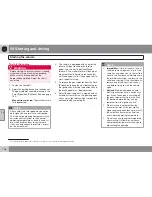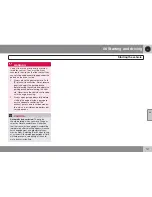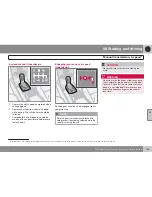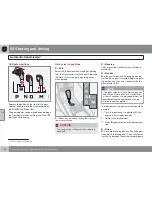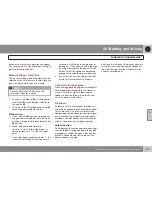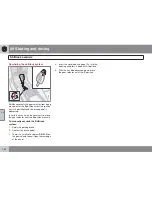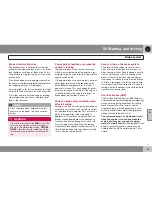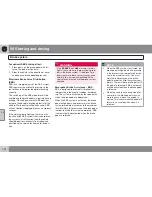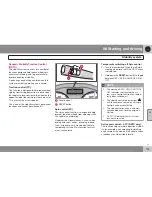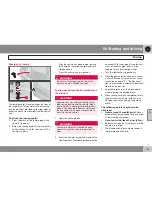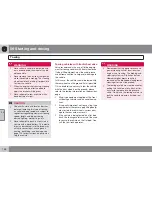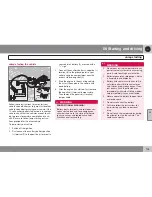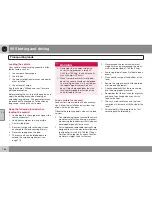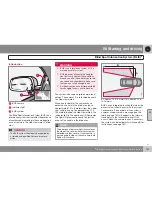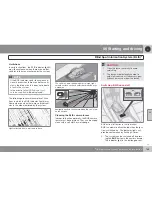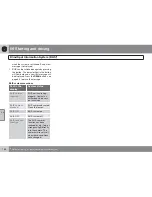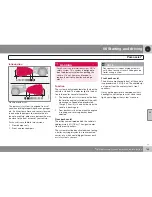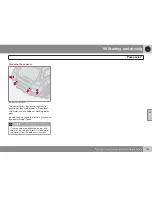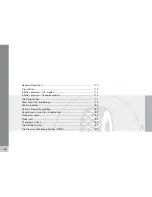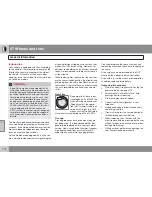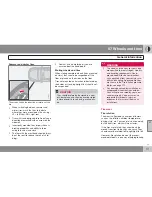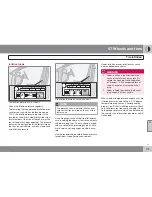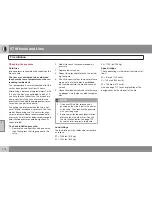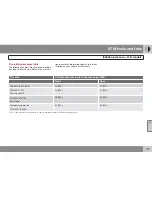
06 Starting and driving
Transporting loads
06
160
Loading the vehicle
Your vehicle's load-carrying capacity is affec-
ted by factors such as:
•
the number of passengers
•
tire inflation
•
the amount of optional or accessory equip-
ment installed
•
the amount of cargo.
See the chapter "Wheels and tires" for more
detailed information.
Before loading the car, turn off the engine, and
apply the parking brake when loading or
unloading long objects. The gear selector can
be inadvertently knocked out of position by
long cargo, causing the car to move.
Keep the following in mind when
loading the vehicle:
•
Load objects in the cargo area against the
rear seat backrest.
•
Load heavy cargo as low as possible.
•
Center wide loads.
•
Secure all cargo with restraining straps
anchored to the load securing eyelets.
•
Cover sharp edges on the load.
•
The rear seats can be folded down to
extend the cargo compartment, see
page 115.
WARNING
•
Remember that an object weighing
44 lbs (20 kg) produces a force of
2,200 lbs (1,000 kg) in a head-on colli-
sion at 30 mph (50 km/h)!
•
When the rear backrest(s) are folded
down, the vehicle should not be loaded
to a level higher than 2 in. (5 cm) below
the upper edge of the rear side win-
dows. Objects placed higher than this
level could impede the function of the
Volvo Inflatable Curtain.
Load carriers (accessory)
Load carriers are available as Volvo accesso-
ries. Follow the installation instructions sup-
plied with the load carriers.
Observe the following points when using load
carriers:
•
To avoid damaging your car and to achieve
maximum safety when driving, we recom-
mend using the load carriers that Volvo has
developed especially for your car.
•
Volvo-approved removable roof racks are
designed to carry the maximum allowable
roof load for this vehicle: 165 lbs (75 kg).
For Non-Volvo roof racks, check the man-
ufacturer's weight limits for the rack.
•
Never exceed the rack manufacturer's
weigh limits and never exceed the maxi-
mum rated roof load of 165 lbs (75 kg).
•
Avoid single-point loads. Distribute loads
evenly.
•
Place heavier cargo at the bottom of the
load.
•
Secure the cargo correctly with appropri-
ate tie-down equipment.
•
Check periodically that the load carriers
and load are properly secured.
•
Remember that the car's center of gravity
and handling change when you carry a
load on the roof.
•
The car's wind resistance and fuel con-
sumption will increase with the size of the
load.
•
Drive smoothly. Avoid rapid starts, fast
cornering and hard braking.
Summary of Contents for 2010 C30
Page 1: ...VOLVO C30 Owner s manual Web Edition...
Page 2: ......
Page 8: ...Contents 8 12 12 Index Index 276...
Page 9: ...Contents 9...
Page 15: ...01 SAFETY...
Page 47: ...01 Safety 01 47...
Page 49: ...02 INSTRUMENTS AND CONTROLS...
Page 50: ...02 Instruments and controls Instrument overview 02 50 G019492...
Page 89: ...03 CLIMATE...
Page 101: ...04 INTERIOR...
Page 111: ...04 Interior Storage compartments 04 111...
Page 121: ...05 LOCKS AND ALARM...
Page 135: ...05 Locks and alarm 05 135...
Page 137: ...06 STARTING AND DRIVING...
Page 169: ...07 WHEELS AND TIRES...
Page 195: ...07 Wheels and tires 07 195...
Page 196: ...G020920 196 Washing and cleaning the car 198 Paint touch up 202...
Page 197: ...08 CAR CARE...
Page 203: ...08 Car care 08 203...
Page 205: ...09 MAINTENANCE AND SERVICING...
Page 235: ...10 AUDIO...
Page 259: ...10 Audio 10 259...
Page 261: ...11 SPECIFICATIONS...
Page 262: ...11 Specifications Label information 11 262...
Page 283: ......
Page 284: ...Kdakd 8Vg 8dgedgVi dc IE JH6 8VcVYV 6I Eg ciZY c HlZYZc iZWdg 8deng i Kdakd 8Vg 8dgedgVi dc...

